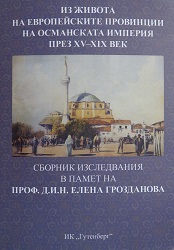Творчески изяви на турските кописти от Самоков (XVII-XIX век)
Creative works of Turkish copyists in the town of Samokov (17th-19th centuries)
Author(s): Stoyanka Kendrova
Subject(s): History, Cultural history, Library and Information Science, Preservation, Other, Local History / Microhistory, Modern Age, Special Historiographies:, 17th Century, 18th Century, 19th Century, The Ottoman Empire
Published by: Издателска къща "Гутенберг"
Keywords: book history; book studies; library and information history; Ottoman empire; Balkan history; History; seventeenth century; eighteenth and nineteenth centuries;
Summary/Abstract: Representatives of the Turkish population in the town of Samokov develop a rich literary activity during the Ottoman period. Seven authors and 47 copyists create a very rich production, especially in 18th century. Ahmed el-Keshfi es-Samakova (d. 1747) is among the most prominent names from the end of 17th - first half of 18th century. He is a prolific writer, copyist, commentator of esoteric works and creator of a rich waqf library in Samokov. His production as a copyist counts 101 volumes, part of which feature collections containing two or more works. The earliest copy - Sharh Manar al-anwar li'n-Nasafi, which is a work in the field of Islamic law, has been completed in 1685.
The analysis of the production of the authors and the copyists from Samokov gives us a reason to define this town as a center of literary activity of the local Muslim population.
- Page Range: 478-509
- Page Count: 32
- Publication Year: 2016
- Language: English, Bulgarian
- Content File-PDF

